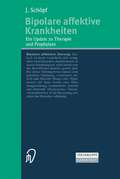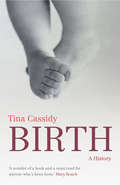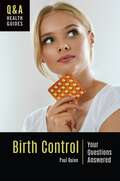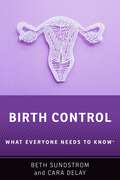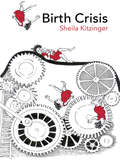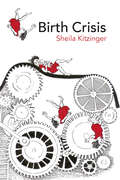- Table View
- List View
Bipolar Disorder in Youth: Presentation, Treatment and Neurobiology
by Stephen M. Strakowski, Melissa P. DelBello and Caleb M. AdlerBipolar disorders affect up to 3% of the world's population and are the 6th leading cause of disability worldwide. The estimated annual costs of bipolar disorder approach $50 billion in the United States, and the associated societal and personal suffering is immeasurable. Bipolar disorder is a lifelong illness that typically begins in mid-adolescence, thereby disrupting healthy developmental processes. It is also a progressive illness, making early intervention even more critical. As the disorder presents differently in youth as it does in adults, considerable controversy exists around the diagnosis in young people. The neurobiological factors leading to the onset of bipolar disorder reflect abnormalities in adolescent brain development. Bipolar disorder is strongly heritable and therefore, these developmental abnormalities likely represent the culmination of processes that precede the expression of symptoms. Current studies of children who are at risk for bipolar disorder are identifying these processes. Again, controversy exists about how to move these neuroscience gains forward to help affected individuals and, particularly to manage children at risk to delay or prevent the onset or progression of bipolar disorder. With these considerations in mind, Bipolar Disorder in Youth provides a timely, focused review of the diagnosis, treatment, and neurobiology of bipolar disorder in youth. It addresses current controversies and resolves those in which evidence is available. The book is organized into three sections based on these topics to provide comprehensive discussions to aid clinicians managing these individuals in their practices, as well as scientists trying to advance the field. The three editors are widely recognized experts in bipolar disorder, and the authors of each chapter represent international experts in the respective topics. Consequently, this book is the most comprehensive volume available discussing this important population and is a 'must' for the libraries of clinicians and scientists working with bipolar children and adolescents.
Bipolar Disorder in Youth: Presentation, Treatment and Neurobiology
Bipolar disorders affect up to 3% of the world's population and are the 6th leading cause of disability worldwide. The estimated annual costs of bipolar disorder approach $50 billion in the United States, and the associated societal and personal suffering is immeasurable. Bipolar disorder is a lifelong illness that typically begins in mid-adolescence, thereby disrupting healthy developmental processes. It is also a progressive illness, making early intervention even more critical. As the disorder presents differently in youth as it does in adults, considerable controversy exists around the diagnosis in young people. The neurobiological factors leading to the onset of bipolar disorder reflect abnormalities in adolescent brain development. Bipolar disorder is strongly heritable and therefore, these developmental abnormalities likely represent the culmination of processes that precede the expression of symptoms. Current studies of children who are at risk for bipolar disorder are identifying these processes. Again, controversy exists about how to move these neuroscience gains forward to help affected individuals and, particularly to manage children at risk to delay or prevent the onset or progression of bipolar disorder. With these considerations in mind, Bipolar Disorder in Youth provides a timely, focused review of the diagnosis, treatment, and neurobiology of bipolar disorder in youth. It addresses current controversies and resolves those in which evidence is available. The book is organized into three sections based on these topics to provide comprehensive discussions to aid clinicians managing these individuals in their practices, as well as scientists trying to advance the field. The three editors are widely recognized experts in bipolar disorder, and the authors of each chapter represent international experts in the respective topics. Consequently, this book is the most comprehensive volume available discussing this important population and is a 'must' for the libraries of clinicians and scientists working with bipolar children and adolescents.
Bipolar Disorder Vulnerability: Perspectives from Pediatric and High-Risk Populations
by Jair C. Soares Consuelo Walss-Bass Paolo BrambillaBipolar Disorder Vulnerability: Perspectives from Pediatric and High-Risk Populations synthesizes our current understanding of high-risk and pediatric populations to aid readers in identifying markers of vulnerability for the development of bipolar disorder, with an ultimate goal of the development of drug targets and other therapies for early diagnosis and treatment. The book provides readers with an understanding of biological and environmental factors influencing disease manifestation that will aid them in defining discrete clinical stages and, importantly, establish an empirical basis for the application of novel therapeutics in a phase of illness during which specific treatments could more effectively alter disease course. Whereas most of the literature available on the pathophysiological mechanisms of bipolar disorder focuses on chronically ill adult individuals, this represents the only book that specifically examines pediatric and high-risk populations. An estimated 30 to 60 percent of adult bipolar disorder patients have their disease onset during childhood, with early-onset cases representing a particularly severe and genetically loaded form of the illness. - Highlights diverse translational methodologies, including functional and structural neuroimaging, neuropsychological testing and integrated genomics - Examines molecular trajectories in youth with bipolar disorder and unaffected youth at high risk for developing bipolar disorder - Explores the interaction between genomic and environmental influences that shape behavior
Bipolar for Psychotherapists and Their Clients
by C. Raymond LakeThis unique book is needed because it aims to improve the care of Bipolar clients while strengthening the clinical practices of non-MD psychotherapists. What is different is the proposal that psychotherapists manage the overall care of Bipolar clients. The increased number of publications about Bipolar over the past decades has enhanced the recognition of Bipolar. As many as 16 million individuals in the US may have a Bipolar episode at some point.Psychiatrists have traditionally managed Bipolar clients but there are not enough psychiatrists and they generally spend only 10 to 15 minutes every one to six months with their clients—often not enough time to recognize oncoming Bipolar episodes. Therapeutic strategy has changed from treating acute episodes to postponing next episodes. Psychotherapists see their clients for 50 minutes every week and are in a better position to recognize developing episodes. Psychotherapists do not prescribe and medicines are usually needed along with psychotherapy for best results. This book encourages psychotherapists to vet and collaborate with prescribers in caring for the therapists’ Bipolar clients.Lacking in the psychotherapists’ armamentarium for treating Bipolar clients is education regarding diagnostic signs, symptoms, and treatment including the most productive medications. This book provides therapists and clients the needed information and encourages academic departments and other psychotherapy programs to institute training about Bipolar Disorders.
Bipolar Psychopharmacotherapy: Caring for the Patient
by Hagop S. Akiskal Mauricio Tohen"If a colleague were to ask me, "What would you recommend I read if I want to become a real expert on bipolarity?" I would respond Bipolar Psychopharmacotherapy: Caring for the Patient." Journal of Bipolar Disorders And the second edition is even better! Bipolar Psychopharmacotherapy covers both pharmacotherapy and the supportive role of psychotherapy, psychoeducation and social approaches to provide a broad integrative philosophy of care for bipolar patients. Extensive coverage is given to special management issues such as the pharmacological care of women with bipolar disorder, children and the elderly, as well as bipolar depression and suicide prevention. The mood swings that characterize bipolar disorder can now be better stabilized in most patients than in the past, but the illness must be carefully managed throughout a person's life. Pharmacotherapy is central to the acute treatment and long-term management and as there are several classes of drugs which are often prescribed concurrently, treatment issues are complex. This essential reference work features critical reviews of the existing literature, plus information on new treatments that have been reported at peer reviewed scientific meetings, often written by the pioneering experts on a particular treatment. The second-generation antipsychotics are now covered in separate chapters to provide in-depth coverage of these agents. There are also new chapters on the pharmacological treatments of mixed states and rapid cycling and novel therapeutic vistas.
Bipolar Psychopharmacotherapy: Caring for the Patient
by Hagop S. Akiskal Mauricio Tohen"If a colleague were to ask me, "What would you recommend I read if I want to become a real expert on bipolarity?" I would respond Bipolar Psychopharmacotherapy: Caring for the Patient." Journal of Bipolar Disorders And the second edition is even better! Bipolar Psychopharmacotherapy covers both pharmacotherapy and the supportive role of psychotherapy, psychoeducation and social approaches to provide a broad integrative philosophy of care for bipolar patients. Extensive coverage is given to special management issues such as the pharmacological care of women with bipolar disorder, children and the elderly, as well as bipolar depression and suicide prevention. The mood swings that characterize bipolar disorder can now be better stabilized in most patients than in the past, but the illness must be carefully managed throughout a person's life. Pharmacotherapy is central to the acute treatment and long-term management and as there are several classes of drugs which are often prescribed concurrently, treatment issues are complex. This essential reference work features critical reviews of the existing literature, plus information on new treatments that have been reported at peer reviewed scientific meetings, often written by the pioneering experts on a particular treatment. The second-generation antipsychotics are now covered in separate chapters to provide in-depth coverage of these agents. There are also new chapters on the pharmacological treatments of mixed states and rapid cycling and novel therapeutic vistas.
Bipolar Psychopharmacotherapy: Caring for the Patient
by Hagop S. Akiskal Mauricio TohenBipolar disorder is often not recognized as an illness, and people may suffer for years before it is properly diagnosed and treated. Like diabetes or heart disease, bipolar disorder is a long-term illness that must be carefully managed throughout a person's life. Pharmacotherapy is central to the acute treatment and long-term management of the disorder and as there are several classes of drugs, which are often prescribed concurrently, treatment issues are complex. This essential reference work examines major pharmacological treatments in the different phases of bipolar disorder. Chapters are devoted to commonly use pharmacological treatments with a critical review of the existing literature. Each chapter includes information not only on studies that have been published but also on new treatments that have been reported in peer reviewed scientific meetings. Bipolar Psychopharmacotherapy covers both pharmacotherapy and the role of psychotherapy, psychoeducation and social approaches to provide a broad integrative philosophy of care for bipolar patients. Extensive coverage is given to special management issues such as the care of women with bipolar disorder, children and the elderly, as well as bipolar depression and suicide prevention. With contributions from the pioneers in the field and an expert editor team, Bipolar Psychopharmacotherapy provides psychiatrists and all mental health practitioners with an invaluable guide to the management of these complex patients. From the reviews: “If a colleague were to ask me, “What would you recommend I read if I want to become a real expert on bipolarity?” I would respond ‘Bipolar Psychopharmacotherapy: Caring for the Patient’.” JOURNAL OF BIPOLAR DISORDERS "... a very useful reference on the pharmacological treatment of bipolar disorder that is written in a very practical and user-friendly format... a must for anyone dealing with patients with bipolar disorder." DOODY'S HEALTH SERVICES "... a multifaceted text with broad clinical value… recommended as an in-office reference for the practicing physician who treats the bipolar patients… to all Health Science libraries as a general reference text." THE ELECTRIC REVIEW
BipolART: Art and Bipolar Disorder: A Personal Perspective
by Denys N. WheatleyWritten with disarming honesty by a long-term sufferer of bipolar disorder, with more than half a century’s experience of intervention and treatment, this highly personal volume traces the effectiveness of a therapy modality for mental illness that has gained much ground in the past two decades: art. The author began to use art, and in particular doodling, from 1998 as a way of externalizing his feelings. Its expressiveness, accessibility and energy-efficiency was ideally suited to the catatonia he experienced during the bouts of depression that are a feature of bipolar disorder, while as the low moods lifted and his energy surged, he completed more ambitious and elaborate works. As well as being highly eclectic, Wheatley’s assembled oeuvre has afforded him both insights and therapeutic intervention into his condition, once deemed highly debilitating and taboo, but much more socially accepted now that well known sufferers such as Stephen Fry have recounted their experiences of the condition. After an opening account of how the images were generated, the volume reproduces a ‘gallery’ of selected work, and then offers an extended epilogue analyzing the art’s connections with the disorder as well as the author’s assessment of how each attempt at visual self-expression was, for him, a therapeutic intervention. Wheatley, a cell biologist who has enjoyed a full career in cancer research, has had no formal training in art, yet his haunting pictures, many of them resembling life forms, are brought to life by his perceptive, self-aware commentary. This book will be of interest to psychologists and psychiatrists among the wider medical profession as well as people suffering from any form of bipolar disorder whatever the severity.
Bird Keeping as a Source of Lung Cancer and Other Human Diseases: A Need for Higher Hygienic Standards (International Archives of Occupational and Environmental Health. Supplement)
by Peter A.J. HolstBirdkeeping is becoming increasingly popular, but could it threaten good health? This book discusses the evi- dence suggesting that keeping pet birds is a strong risk factor for lung cancer. Its relation to a number of other endpoints, including death before age 60 and spontaneous abortion, is also examined. In addition, the book looks at the diseases that can be transmitted from birds to man - a fairly unknown field in general medicine. For instance, birds are a source of airborne particles that can cause allergic reactions in humans. People who keep birds as pets tend to have a higher incidence of shortness of breath, colds, sore throats and other flu-like symptoms than those in households without birds. The evidence presented in this book is the result of a ten-year general practice survey. Some recommendations for future research are given.
Birds of Prey: Health and Disease
by John E. CooperRaptor biology has evolved enormously since the publication of the original edition of this book under the title Veterinary Aspects of Captive Birds of Prey. With the help of leading international experts, John E. Cooper has updated and expanded this classic reference to include all the latest data on the health and diseases of raptors. While still serving the needs of veterinary surgeons who treat birds of prey, Birds of Prey: Health & Disease also appeals to a wide readership of falconers, avian researchers, breeders, rehabilitators and zoo staff. Important changes to this new edition are the inclusion of data on free-living birds, additional material on fractures, pathology, legislation and poisons, and new sections on neonatology, health monitoring, captive-breeding and host-parasite relations. This book reviews all aspects of birds of prey, giving invaluable up-to-date information on diseases and pathology, but also looking at the history of the subject, the origins of terms, the evolution of current thinking and ending with a reliable list of primary references for further reading.
Birth: A History
by Tina CassidyThe engaging and eye-opening story of how we and our ancestors entered the world.Through the frigid, blurry January weeks after George was born, I found myself suddenly housebound with time to ruminate - though not time to cook or take a shower. When George was peaceful, my mind returned to that nagging question: why is birth so hit and miss after all this time? I needed to put into perspective my own experience. I needed to know what other women, in other cultures, in other times had done.Birth is a book that will open the eyes of even the most informed experts on the subject. Cassidy looks at every aspect of childbirth - from fathers and mothers to doctors and widwives across the centuries - with admirable objectivity in a work that is utterly gripping, occasionally shocking and essential reading for the human race.
Birth Control: Your Questions Answered (Q&A Health Guides)
by Paul QuinnThis book will serve as a scientifically accurate yet easy-to-read introduction to birth control for teens and young adults. The information, guidance, and resources it offers will help readers to make better decisions regarding their sexual health.From barrier methods such as condoms and diaphragms to oral contraceptive pills and from hormone-based implants and injectables to permanent sterilization techniques, there are a number of ways to prevent unwanted pregnancy today. But which are the most effective, and how do you choose the method that's right for you? What about side effects and long-term implications for health, such as increased risk for cancer? Does birth control affect your chances of getting pregnant in the future? Birth Control: Your Questions Answered, a part of Greenwood's Q&A Health Guides series, provides clear, concise answers to these and other questions young readers may have about this sometimes embarrassing, yet very important, topic. Each book in this series follows a reader-friendly question-and-answer format that anticipates readers' needs and concerns. Prevalent myths and misconceptions are identified and dispelled, and a collection of case studies illustrates key concepts and issues through relatable stories and insightful recommendations. The book also includes a section on health literacy, equipping teens and young adults with practical tools and strategies for finding, evaluating, and using credible sources of health information both on and off the internet—important skills that contribute to a lifetime of healthy decision-making.
Birth Control: Your Questions Answered (Q&A Health Guides)
by Paul QuinnThis book will serve as a scientifically accurate yet easy-to-read introduction to birth control for teens and young adults. The information, guidance, and resources it offers will help readers to make better decisions regarding their sexual health.From barrier methods such as condoms and diaphragms to oral contraceptive pills and from hormone-based implants and injectables to permanent sterilization techniques, there are a number of ways to prevent unwanted pregnancy today. But which are the most effective, and how do you choose the method that's right for you? What about side effects and long-term implications for health, such as increased risk for cancer? Does birth control affect your chances of getting pregnant in the future? Birth Control: Your Questions Answered, a part of Greenwood's Q&A Health Guides series, provides clear, concise answers to these and other questions young readers may have about this sometimes embarrassing, yet very important, topic. Each book in this series follows a reader-friendly question-and-answer format that anticipates readers' needs and concerns. Prevalent myths and misconceptions are identified and dispelled, and a collection of case studies illustrates key concepts and issues through relatable stories and insightful recommendations. The book also includes a section on health literacy, equipping teens and young adults with practical tools and strategies for finding, evaluating, and using credible sources of health information both on and off the internet—important skills that contribute to a lifetime of healthy decision-making.
Birth Control: What Everyone Needs to Know® (What Everyone Needs to Know)
by Beth L. Sundstrom Cara DelayBirth control offers women the opportunity to prevent pregnancy, plan and space their births, or have no births at all. And yet, in the United States, half of all pregnancies remain unintended, and access to birth control is beset by inequities in education, access, and coverage. Research indicates that women are familiar with the range of contraceptive methods available today. But the persistently high rates of unintended pregnancy, combined with common dissatisfaction and discontinuation, suggest that women's contraceptive needs continue to be unmet. Birth Control: What Everyone Needs to Know® will offer more than a user's guide to available means of contraception: it will examine how supported family-planning infrastructure impacts society as a whole. Through reviews of policy, scientific literature, and supplemental interviews with women, it will uncover women's concerns and apprehensions about contraception, as well as the ways birth control empowers women and increases access to educational and professional opportunities. It will provide an overview the history of birth control, the risks and benefits of contraception, the role of menstruation, and the future of birth control. The goal of this book is to provide accurate, unbiased scientific information about contraception in the context of women's lived experiences and the realities of how individuals make decisions about birth control.
BIRTH CONTROL WENK C: What Everyone Needs to Know® (What Everyone Needs to Know)
by Cara Delay Beth L. SundstromBirth control offers women the opportunity to prevent pregnancy, plan and space their births, or have no births at all. And yet, in the United States, half of all pregnancies remain unintended, and access to birth control is beset by inequities in education, access, and coverage. Research indicates that women are familiar with the range of contraceptive methods available today. But the persistently high rates of unintended pregnancy, combined with common dissatisfaction and discontinuation, suggest that women's contraceptive needs continue to be unmet. Birth Control: What Everyone Needs to Know® will offer more than a user's guide to available means of contraception: it will examine how supported family-planning infrastructure impacts society as a whole. Through reviews of policy, scientific literature, and supplemental interviews with women, it will uncover women's concerns and apprehensions about contraception, as well as the ways birth control empowers women and increases access to educational and professional opportunities. It will provide an overview the history of birth control, the risks and benefits of contraception, the role of menstruation, and the future of birth control. The goal of this book is to provide accurate, unbiased scientific information about contraception in the context of women's lived experiences and the realities of how individuals make decisions about birth control.
Birth controlled: Selective reproduction and neoliberal eugenics in South Africa and India (Governing Intimacies in the Global South)
by Amrita PandeBirth controlled analyses the world of selective reproduction – the politics of who gets to legitimately reproduce the future – through a cross-cultural analysis of three modes of ‘controlling’ birth: contraception, reproductive violence and repro-genetic technologies. It argues that as fertility rates decline worldwide, the fervour to control fertility, and fertile bodies, does not dissipate; what evolves is the preferred mode of control. Although new technologies like those that assist conception or allow genetic selection may appear to be an antithesis of other violent versions of population control, this book demonstrates that both are part of the same continuum. All population control policies target and vilify women (Black women in particular), and coerce them into subjecting their bodies to state and medical surveillance; Birth controlled argues that assisted reproductive technologies and repro-genetic technologies employ a similar and stratified burden of blame and responsibility based on gender, race, class and caste. To empirically and historically ground the analysis, the book includes contributions from two postcolonial nations, South Africa and India, examining interactions between the history of colonialism and the economics of neoliberal markets and their influence on the technologies and politics of selective reproduction.The book provides a critical, interdisciplinary and cutting-edge dialogue around the interconnected issues that shape reproductive politics in an ostensibly ‘post-population control’ era. The contributions draw on a breadth of disciplines ranging from gender studies, sociology, medical anthropology, politics and science and technology studies to theology, public health and epidemiology, facilitating an interdisciplinary dialogue around the interconnected modes of controlling birth and practices of neo-eugenics.
Birth controlled: Selective reproduction and neoliberal eugenics in South Africa and India (Governing Intimacies in the Global South)
by Amrita PandeBirth controlled analyses the world of selective reproduction – the politics of who gets to legitimately reproduce the future – through a cross-cultural analysis of three modes of ‘controlling’ birth: contraception, reproductive violence and repro-genetic technologies. It argues that as fertility rates decline worldwide, the fervour to control fertility, and fertile bodies, does not dissipate; what evolves is the preferred mode of control. Although new technologies like those that assist conception or allow genetic selection may appear to be an antithesis of other violent versions of population control, this book demonstrates that both are part of the same continuum. All population control policies target and vilify women (Black women in particular), and coerce them into subjecting their bodies to state and medical surveillance; Birth controlled argues that assisted reproductive technologies and repro-genetic technologies employ a similar and stratified burden of blame and responsibility based on gender, race, class and caste. To empirically and historically ground the analysis, the book includes contributions from two postcolonial nations, South Africa and India, examining interactions between the history of colonialism and the economics of neoliberal markets and their influence on the technologies and politics of selective reproduction.The book provides a critical, interdisciplinary and cutting-edge dialogue around the interconnected issues that shape reproductive politics in an ostensibly ‘post-population control’ era. The contributions draw on a breadth of disciplines ranging from gender studies, sociology, medical anthropology, politics and science and technology studies to theology, public health and epidemiology, facilitating an interdisciplinary dialogue around the interconnected modes of controlling birth and practices of neo-eugenics.
Birth Crisis
by Sheila KitzingerOne new mother in twenty is diagnosed with traumatic stress after childbirth. In Birth Crisis Sheila Kitzinger explores the disempowerment and anxiety experienced by these women. Key topics discussed include: increasing intervention in pregnancy the shift in emphasis from relationships to technology in childbirth how family, friends and professional caregivers can reach out to traumatized mothers how women can work through stress to understand themselves more deeply and grow in emotional maturity how care and the medical system needs to be changed. Birth Crisis draws on mothers' voices and real-life experiences to explore the suffering after childbirth which has, until now, been brushed under the carpet. It is a fascinating and useful resource for student and practising midwives, all health professionals, and women and their families who want to learn how to overcome a traumatic birth.
Birth Crisis
by Sheila KitzingerOne new mother in twenty is diagnosed with traumatic stress after childbirth. In Birth Crisis Sheila Kitzinger explores the disempowerment and anxiety experienced by these women. Key topics discussed include: increasing intervention in pregnancy the shift in emphasis from relationships to technology in childbirth how family, friends and professional caregivers can reach out to traumatized mothers how women can work through stress to understand themselves more deeply and grow in emotional maturity how care and the medical system needs to be changed. Birth Crisis draws on mothers' voices and real-life experiences to explore the suffering after childbirth which has, until now, been brushed under the carpet. It is a fascinating and useful resource for student and practising midwives, all health professionals, and women and their families who want to learn how to overcome a traumatic birth.
Birth Defects in India: Epidemiology and Public Health Implications
by Anita KarThis book presents the epidemiology of birth defects and their public health and social implications in India. As neglected childhood disorders, birth defects remain invisible in global maternal and child health dialogues. Birth defects services are emerging in India. This book approaches birth defects from a public health perspective, identifying the core functions of a birth defects service. Keeping in mind the complex task of providing multidisciplinary services for children with disabilities and complex medical conditions, the book examines the basic public health activities that have been put in place to address these conditions in India. The book describes birth defects surveillance and the challenges of acquiring accurate and timely data on birth defects against the background of India’s mixed health system. It discusses opportunities for prevention of birth defects and describes the structure and function of an emergent genetic service. It explores issues related to an integrated service for children with special healthcare needs, such as screening, early intervention, and rehabilitation. Furthermore, it describes the impact of these conditions on caregivers, including birth defects stigma. This book not only addresses a knowledge gap in the field of public health in India, but also explores the broader issues of services for children with disabilities and disabling conditions in low and low-middle income settings where access to health care is not universal. Given the depth and breadth of its coverage, the book offers an essential resource for birth defects researchers, researchers in the field of maternal and child health, public health/ global health, disability researchers, and researchers from the fields of rehabilitation sciences, nursing and anthropology. This book will be a valuable read for social medicine/community medicine departments, global health courses, and public health schools in India and other low middle-income countries.
Birth Figures: Early Modern Prints and the Pregnant Body
by Rebecca WhiteleyThe first full study of “birth figures” and their place in early modern knowledge-making. Birth figures are printed images of the pregnant womb, always shown in series, that depict the variety of ways in which a fetus can present for birth. Historian Rebecca Whiteley coined the term and here offers the first systematic analysis of the images’ creation, use, and impact. Whiteley reveals their origins in ancient medicine and explores their inclusion in many medieval gynecological manuscripts, focusing on their explosion in printed midwifery and surgical books in Western Europe from the mid-sixteenth to the mid-eighteenth century. During this period, birth figures formed a key part of the visual culture of medicine and midwifery and were widely produced. They reflected and shaped how the pregnant body was known and treated. And by providing crucial bodily knowledge to midwives and surgeons, birth figures were also deeply entangled with wider cultural preoccupations with generation and creativity, female power and agency, knowledge and its dissemination, and even the condition of the human in the universe. Birth Figures studies how different kinds of people understood childbirth and engaged with midwifery manuals, from learned physicians to midwives to illiterate listeners. Rich and detailed, this vital history reveals the importance of birth figures in how midwifery was practiced and in how people, both medical professionals and lay readers, envisioned and understood the mysterious state of pregnancy.
The Birth House (P. S. Ser.)
by Ami McKayIn a tale spanning the 20th century, Ami McKay takes a primitive and superstitious rural community in Nova Scotia and creates a rich tableau of characters to tell the story of childbirth from its most secretive early practices to modern maternity as we know it.






